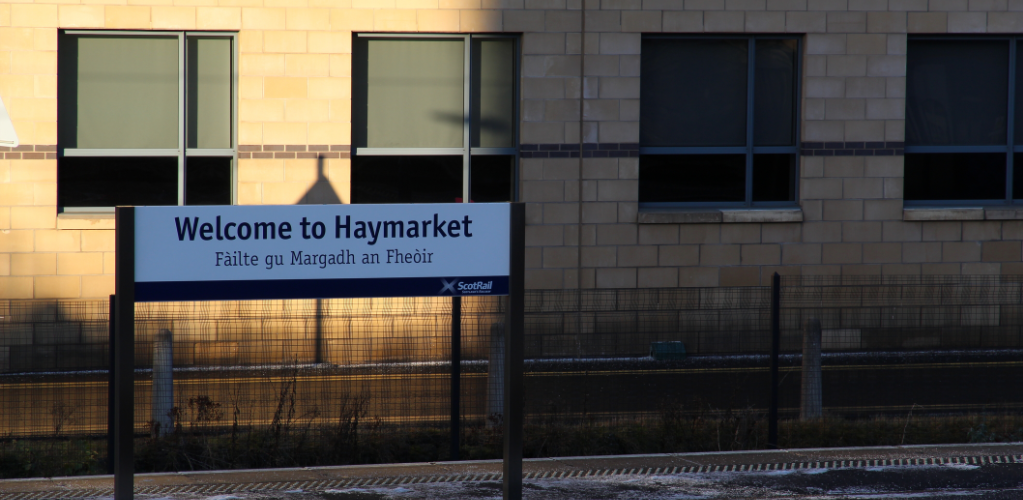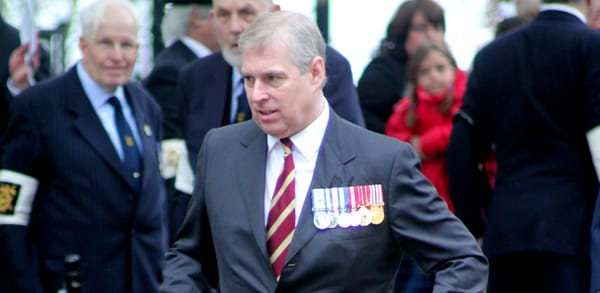Andrew Marr, Gaelic and Scots
Andrew Marr’s comments at the Labour Party conference dismissing Gaelic signage at Edinburgh’s Haymarket station highlight ongoing ignorance about Scotland’s linguistic history. Despite Marr’s apology, his remarks underscored cultural marginalisation, Wee Ginger Dug argues.

TL;DR | Highlights from this story
● Andrew Marr’s comments on Gaelic signage reflect a common misconception about the language’s presence in Lowland Scotland.
● Gaelic was historically spoken across many Lowland areas, including Edinburgh, with roots in place names.
● Gaelic’s significance goes beyond linguistic history, as it is central to Scotland’s national identity.
● Marr later apologized for his statements, but the response highlights deep cultural tensions regarding Scottish languages.
T his is an expanded version of a piece I wrote for The National a few days ago. I’m reposting it here with some additions in light of Marr’s apology for his insulting and ignorant comments about the Gaelic language and its place in Scottish culture.
It’s the sad and ignorant old trope that never dies, prominent opponents of independence complaining about Gaelic language signage in Scottish train stations on the factually incorrect grounds that “Gaelic was never spoken [here, somewhere] in the Lowlands.”
These complaints are invariably attempts to insinuate that vile nationalists are stoking up division in an attempt to show that Scotland really is a country and a nation in its own right with all the attributes that traditionally go along with nationhood, such as a language of its own. The latest to make a public display of his arrogant Anglo-British nationalist wilful ignorance is the former BBC broadcaster Andrew Marr, who told a fringe meeting at this week’s Labour Party conference that it was “ridiculous” and “offensive” that there is Gaelic language signage at Edinburgh’s Haymarket train station, where the name of the station is given in Gaelic as Margadh an Fheòir.
Wait until he finds out that Waverley station is named in Gaelic too. Gaelic for Waverley is Waverley.
Speaking at an “In Conversation” event with Anas Sarwar at Labour conference, Marr segued from an audience question about promoting the Welsh language to go off on an ill-informed rant about Gaelic, saying: “I find it equally offensive that all sorts of parts of Scotland, which have never been Gaelic, have never had Scots spoken [have Gaelic signs].”
He then asked: “Why does Haymarket [station] have to have the Gaelic for Haymarket under it? It’s ridiculous.”
Leaving aside for the moment Marr’s obvious confusion between Gaelic and Scots, which alone ought to disqualify him from having a platform for his ignorance about Scotland’s linguistic heritage, never mind a platform bearing a Gaelic railway station sign, Gaelic was indeed once spoken in Edinburgh. It may not have been the majority language of Midlothian, but there was a time, around the 1100s, when Midlothian and Edinburgh were home to a significant and substantial native Gaelic-speaking population which was culturally and politically important.
This Edinburgh native Gaelic population has left its mark in a number of place names in and around the city. These include Balerno from Gaelic Baile Àirneag, farm of the sloe trees, Craigentinny from Creag an t-Sionnaich, the rock of the fox, Torphin from Torr Fionn, white tor or tower, Bonaly from Bonn-aillidh, the place at the foot of the rocks, Craigmillar from Creag a’ Mhaol Àird, the rock of the bare summit, Corstorphine from Crois Thoirfinn, Thorfinn’s cross, amongst others. The place names of Midlothian were well explored and documented in a University of Edinburgh PhD thesis by Norman Dixon in 1947, which finds that Gaelic place names are numerous in the former county and notes that Gaelic became current in the Lothians after the region was incorporated into the kingdom of Scotland.
Gaelic was once widespread across Lowland Scotland; a recent five-volume survey of Fife place names carried out by Simon Taylor of Glasgow University finds that Fife was overwhelmingly Gaelic in language in the 1100s, the high water mark of the Gaelic language in Scotland.
For all that the likes of Andrew Marr are keen to insist that Gaelic was never spoken in the Lowlands, during this period Gaelic was also dominant in West Lothian, and was even present in East Lothian and Peebleshire. Gaelic was also the dominant language in North Lanarkshire, Ayrshire, and Renfrewshire, Angus and Aberdeenshire. The oldest Scottish Gaelic manuscript is the Book of Deer, a 10th-century Latin Gospel Book with early 12th-century additions in Latin, Old Irish and Scottish Gaelic. It contains the earliest surviving Gaelic writing from Scotland and was written by the Gaelic speaking monks of Deer in Buchan.
Gaelic was also found in Dumfrieshire and the southwest and was particularly strong in Galloway and South Ayrshire. Native Gaelic-speaking communities were once found everywhere in Lowland Scotland north and west of a line drawn roughly from Dumfries Dùn Phris ‘fort of the thicket’ to Inveresk ‘Inbhir Easg ‘mouth of the Esk’ in East Lothian east of Edinburgh. There is even evidence of a Gaelic-speaking land-owning class in the far southeast of the country. Longformacus in Berwickshire bears an unquestionably Gaelic name, Longphort Mhacais, ‘the hunting camp of Macas’.
Lowland Gaelic clung on until surprisingly late. Parts of Stirlingshire still had native Gaelic speakers well into the 20th century. The last known speaker of Gaelic in South West Scotland was Margaret McMurray, who lived near Maybole in South Ayrshire and died in 1761. Recent research strongly suggests that there were still Gaelic speakers in South Ayrshire until the early decades of the 1800s.

— A sign to keep dogs on leash in Gaelic and English languages on the Isle of Skye, Scotland.
Scotland has always been a multilingual country. Scots is likewise a national language of Scotland. Pictish and Cumbric (the P-Celtic language once spoken in Southern Scotland) are not and cannot be national languages of Scotland as they survive only in a few linguistic scraps; they are fossil languages which cannot be revived. Gaelic and Scots are very much still alive, despite the best efforts of Anglo-centric Scots to marginalise them.
However, Gaelic has a special claim to the status of the original national language of Scotland since the entire Scottish nation is named for it. The name Scot was originally an exonym, a name given to a nation or linguistic group by others. Finland is likewise an exonym. Finns call their country Suomi and themselves Suomilainen. In the early Middle Ages, Scotti – which is of obscure origin – was the name used by Latin speakers to refer to Gaelic speakers. Due to the prestige of Latin, the Latin name for Gaelic speakers was widely adopted by other European languages. At that point no distinction was made between the Gaelic of Scotland and that of Ireland, they were still the same language, forming a single Gaelic speaking linguistic and cultural region which stretched from Kerry to Caithness.
In Old English the name Scotland – the land of the Gaelic speakers – referred to Ireland, it was only later after English borrowed the Old Norse name Ireland to refer to the island of Ireland that the name Scotland came to mean those parts of the island of Britain which were Gaelic in speech, modern Scotland. The Gaelic language was not at one time merely spoken just about everywhere in Scotland with the sole exception of the Northern Isles including being spoken natively the area of modern Edinburgh, it was also central to the very creation of Scotland as a nation. Scotland literally means ‘land of the Gaelic speakers’. Without Gaelic, there would be no Scotland, and Andrew Marr would have no “Scottish Labour” event at which to display his ignorance.
However, the truly chilling thing is that upon making a public display of his ignorance and his contempt for a core piece of Scottish culture and an emblem of Scottish national identity, Marr was applauded by the Labour Party delegates in attendance. Contempt for Scottish culture and nurturing of the Cringe is every bit as much a part of the DNA of the Labour Party as it is for the Conservatives and the frothing Scottish supporters of the openly English nationalist Reform UK.
What is truly ridiculous and offensive is that public figures like Marr can receive attention and applause for their lack of knowledge of basic information about a key facet of Scottish culture which in any other nation would be taught in primary schools.
Marr has now accepted that he was wrong and posted on X:
“Right. On the Gaelic business. Sometimes when good friends take you kindly to one side and explain patiently why you are completely wrong, you have to accept that you are completely wrong. I have long thought that what the great Scottish medieval poets called ‘inglis’ and the 20th century ones Lallans, is being pushed aside in modern memory and use… But I got overexcited and was wrong. Whatever is the Gaelic for sorry, that…”
Marr has at least admitted he was wrong on Gaelic, but it beggars belief that his objection to a Gaelic language sign in Haymarket train station was because he thought there ought to have been a sign in Scots instead of or as well as the Gaelic one. The very same people who object to Gaelic signage would just as vociferously object to signage in Scots, and in that regard, it’s telling that Marr could not bring himself to call Scots, Scots.
Scots is a national language of Scotland by virtue of its geographical spread in Scotland and the fact that it was the state language of Scotland when it was an independent country from circa 1400 until 1707. Scots was the language of the Scottish royal court and the Scots legal system. As such, it was well on the way to full codification and standardisation, a process which was aborted due to the political decision made during the reign of James VI /James I of England for Scotland to adopt the English language of the bible promoted by the King – the King James Bible. Nevertheless Scots continued and still continues to be widely spoken in Scotland in the Lowlands and the Northern Isles. Its status as a language in its own right is widely accepted by linguists.
To put it simply, Gaelic is a national language of Scotland because it is the language which created the Scottish nation, Scots is a national language of Scotland because it is the language of the independent state created by the Scottish nation. English is also a national language of Scotland because it is overwhelmingly the dominant written and spoken language in modern Scotland, albeit with a considerable amount of influence from Scots.
There is still no commonly agreed spelling system or standard form for Scots, and attempts by individual writers to develop these are denounced by Marr’s British nationalist friends as artificial and dismissed on the grounds of “no one speaks like that” or by claiming falsely that Scots is not really a language. The Scots for Haymarket is Heymercat – although other Scots versions are possible – but putting that on the station sign along with Haymarket and Margadh an Fheòir would only lead to further paroxysms of pearl-clutching from British nationalists in search of something to feel victimised by.

GOING FURTHER
Andrew Marr brands spread of Gaelic signs ‘ridiculous’ | DAILY MAIL
Scottish broadcaster Andrew Marr apologies after branding Gaelic signs in Scotland ‘offensive’ | THE SCOTSMAN
Western Isles MP slams ‘Dundee-centred’ Andrew Marr in row over Gaelic signs | THE PRESS & JOURNAL
I speak Gaelic. Here’s why Andrew Marr is wrong about road signs | THE NATIONAL
Marr says sorry for Gaelic gaffe as importance of language explained | THE HERALD
Andrew Marr was wrong, Gaelic belongs to us all | THE TIMES






[Read our Comments Guidelines]